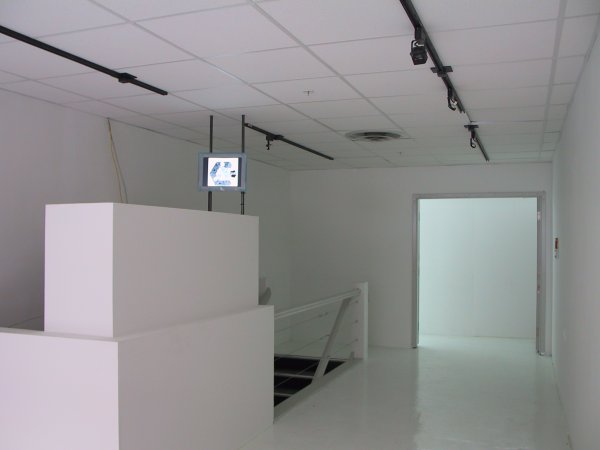
EXISTech Employee number 9432,
2002 September 11th
Decon is short for Decontamination (e.g. stripdown and washdown in response to anthrax scares, etc.), but the term ``decon'' is also a short form for ``deconstruction'' (literary criticism asserting multiple conflicting interpretations of philosophical, political, or social implications rather than an author's intention). This exhibit attempts to demonstrate how we have all become interdependent on technological extensions of the mind and body, and hence, to some degree, have all taken a first step to becoming cyborgs. The exhibit also attempts to show how authorities might view the cyborg being as a threat, therefore requiring that it be stripped of these extensions. The cyborg body, whether by way of a wearable computer, or by pens, pencils, portable data organizers, shoes, clothing, eyeglasses, and other personal effects, is potentially contaminated, and thus requires cleansing.
Foucault described how authorities once used the specter of plague to justify draconian quieting of any civil unrest. Just the mere mention of the word ``plague'' could be used for quarantine or forced mass evacuations. Forced evacuation to mass delousing centers, cleansing stations, or the like, has sometimes been used to remove undesirables from a given area. Even ``ethnic cleansing'' could fall under the domain of decontamination (``decon'').
Harvard University's Kennedy School of Government describes powers that responding agencies might desire:
(See http://wearcam.org/decon/index.htm for more similar quotes, excerpts, and background information.)
DECONference was conceived as a probe into society, and to understand the culture and technology of mass decontamination. In the exhibit, decontamiation was deconstructed by literally building a futuristic mass decontamination facility, as might form the entrance to a space station or airport of the future, or as an entranceway into a high security government building or industrial facility such as a factory. In such a future world, an alleged need for cleanliness (decon) might also be used as justification for a mass decontrabanding (including a search of personal belongings).
Initially all passengers or persons entering a "clean facility" are assumed to be potentially contaminated. Since we don't know which if any of these persons are guaranteed to be free of contaminants, everyone must undergo decon (decontrabanding and decontamination).
This involves a 2 step process:
In this exhibit of 2002 August 29th, 7pm, attendees had the option of processing through decon, although in an actual incident, military forces would be present to require all civilians to undergo decon. In this exhibit, all but one person chose to undergo decon. The one ejectee was escorted out through the back door, into the parking lot, whereas everyone else was processed through decon to attend the event.
Persons entering the exhibit are referred to as "suspects" because we do not know whether or not they are contaminated or carrying contraband, so we suspect them of being contaminated or of carrying contraband.
All suspects must remove their shoes at the door, upon entry into the
exhibit space. At the entrance, each suspect is given a large heavy duty
clear plastic bag, called a "contrabag" (contraband bag),
in which to carry their own shoes in. Additionally, each suspect
is tagged with a neck-worn numbered identification tag.
The suspects gather in the main exhibit hall
to hear the initial address
by Professor Arthur Kroker, followed by an address by
Professor Derrick de Kerckhove (Director of the McLuhan Program on
Culture and Technology).

Suspects are next separated by gender. Suspects are processed in groups of
12 persons of the same gender at a time.
Initially 12 men are admitted into the decontrabanding gallery,
where Julia Scher provides her address remotely,
by way of loudspeakers placed in the
decontrabanding gallery. Her
comforting voice helps to make the suspects
feel safe and secure.
The decontrabanding gallery is a nice clean white space, free of contamination,
as shown below:
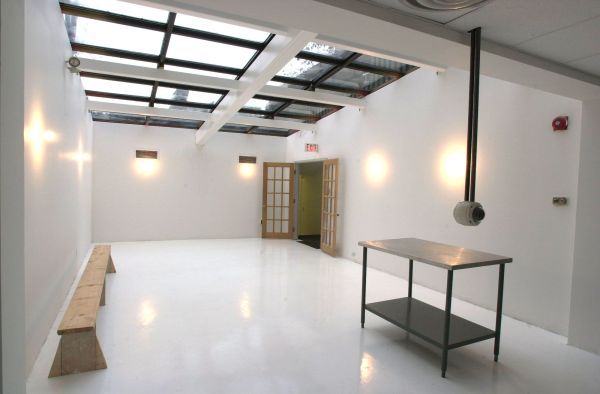
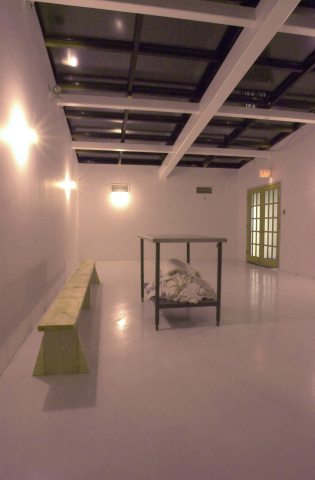 .
.
In this gallery there is a wooden bench that is exactly 12 feet long,
upon which the 12 men are asked to seat themselves.
There is a stainless steel surgical table in front of the bench.
Initially a decon officer asks each person to empty his pockets onto the table
to make sure that there is no obvious contraband (guns, knives, nail clippers,
box cutters, etc.). Next the men are asked to remove all clothing,
jewellery, and personal effects. They are each instructed to
place these items into the clear plastic contrabag with their shoes.
Contrabags are checked in at the bagging counter, where a bagging officer
seals the bags with a tie wrap gun with a serial-numbered evidence tag.
The bagging counter is illustrated below:
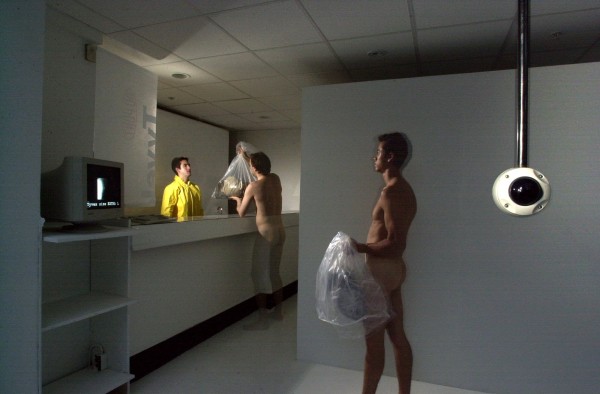
Notice also the body scanner rightmost in the picture. This will be
explained later, and is used after the suspects return from decontamination.
So next the 12 suspects (at this time naked) are lined up against the back wall.
Six men are asked to move forward into the decontamination chamber.
The decontamination chamber features a six-person sensor operated column
shower:
 .
.
The shower column is held down with stainless steel cap screws, to a cast
iron base that is cemented into the floor. The cast iron base provides both
the drain, as well as the supply of water. Additionally, there are various
hookups such as coaxial cables, ethernet, etc., inside the hollow waterproof
column.
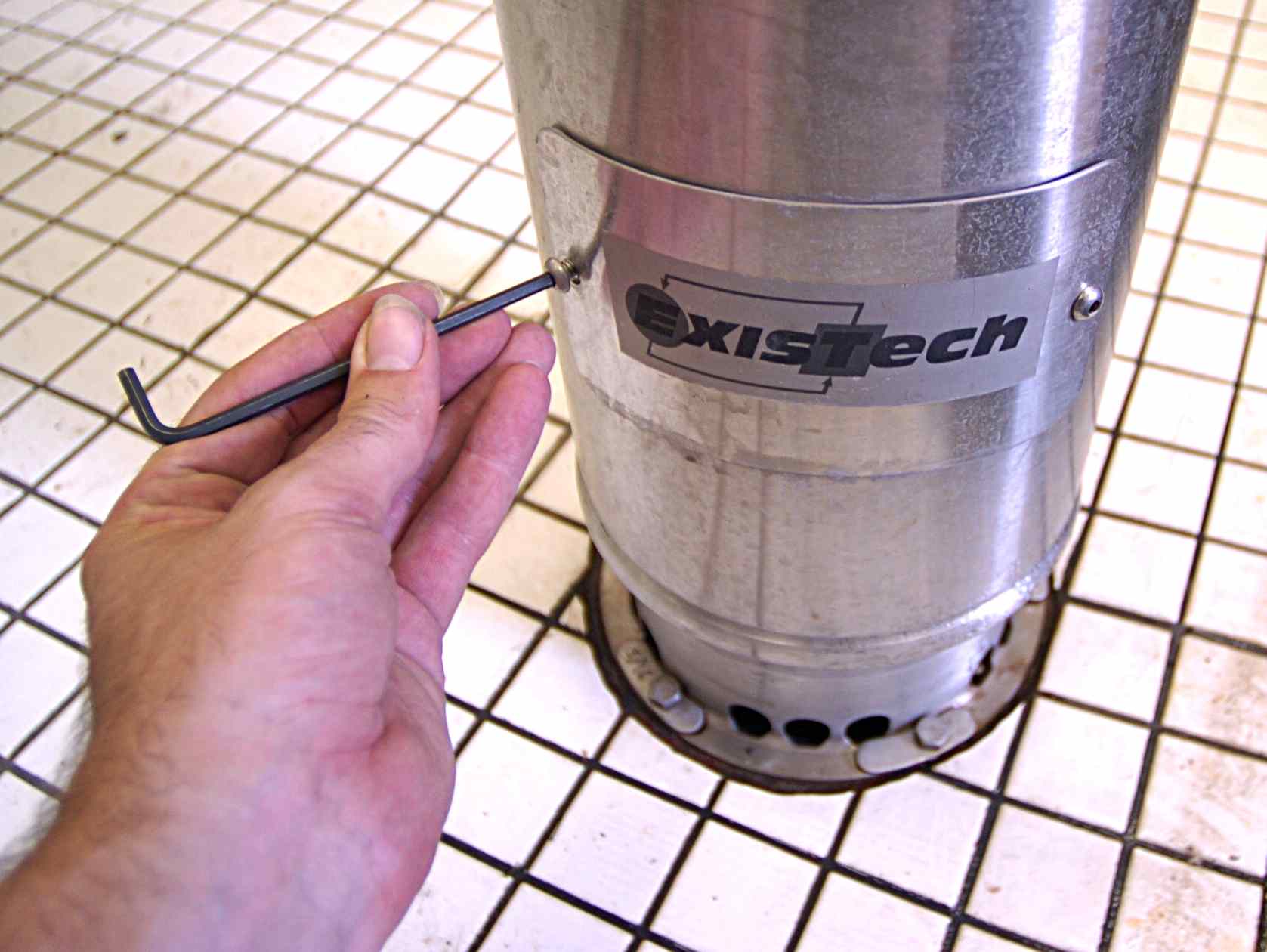
You can take a look inside the access hatch of the column shower.
The shower is in a clean white room, having three design elements,
as shown below, left-to-right:

 ;
;
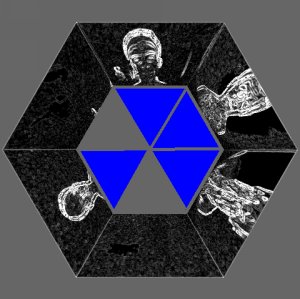
Manual override may be done with a hexagonal-shaped (de)control panel,
as shown below:
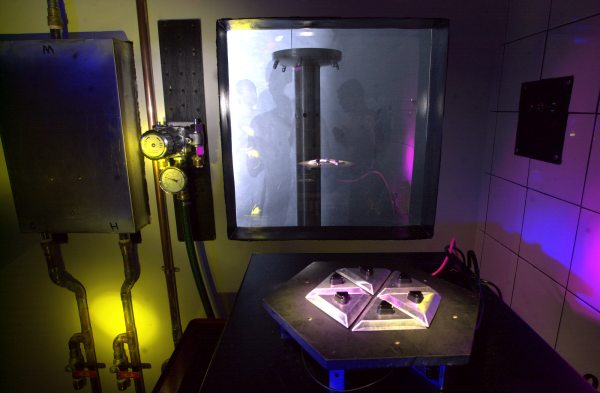
The decontrol panel comprises six triangular metal plates with a triangle-shaped
pushbutton switch on each one, the six triangles making up the hexagonal
shape of the panel. The panel is oriented and wired so that there is a
one-to-one correspondence with the six nozzles as viewed through the
mirror/window. Because the decontrol room is dark, the mirror/window
functions as a mirror when viewed from the shower room, and as a window when
viewed from the decontrol room side. In order to protect the privacy
of the decontaminees, the Chief Privacy Officer (CPO) ensures that the
operator is a person of the same gender as those undergoing decontamination.
As the first six men are undergoing decontamination, the next six men
are directed into the shower room. After the two sets of six men
have been decontaminated, all 12 of them line up along the wall
opposite the bench.
They are directed one-by-one to stand in front of the body scanner.
The body scanner is shown below:
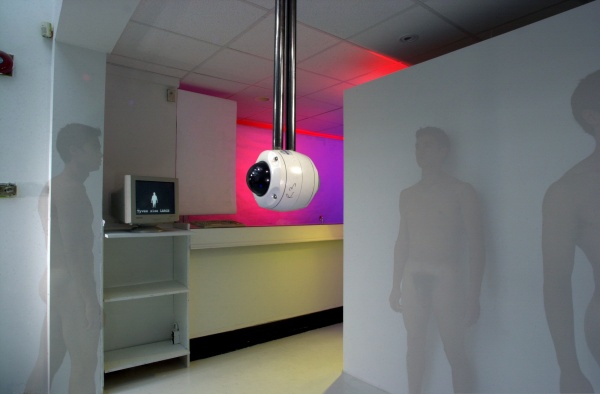
The body scanner comprises an infrared sensor array connected to
a DEC Alpha supercomputer. It calculates all body dimensions,
and computes the optimal design for a uniform. This information can
then be used to either custom-tailor a uniform, or to select from a fixed
stock of pre-made uniforms. In this exhibit, the uniforms are all pre-made,
of white Tyvek (TM).
Here is a screen capture from the body scanner:
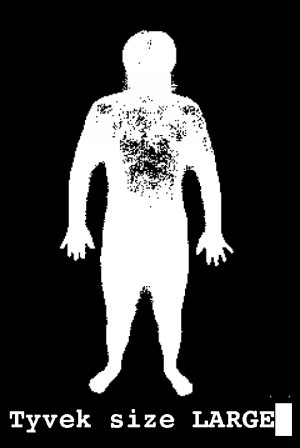
The process is very streamlined and works quickly, so that thousands of people could, in principle, be processed in such a facility, in a short period of time.
The figure below illustrates the process:
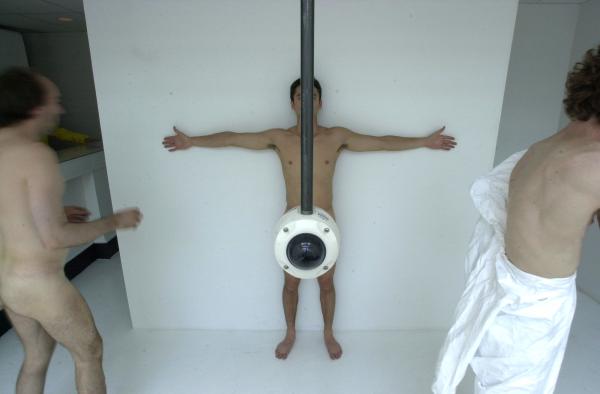
People lined up at the left proceed to be scanned, and are quickly handed
a Tyvek (TM) jumpsuit in their size, and then put it on and line up at the
right. The white jumpsuits have no pockets in which to conceal contraband.
The body scanner is mounted from the suspended ceiling by way of steel tubing,
and all the wiring runs inside the steel tubing to give it a nice clean look,
as shown below:
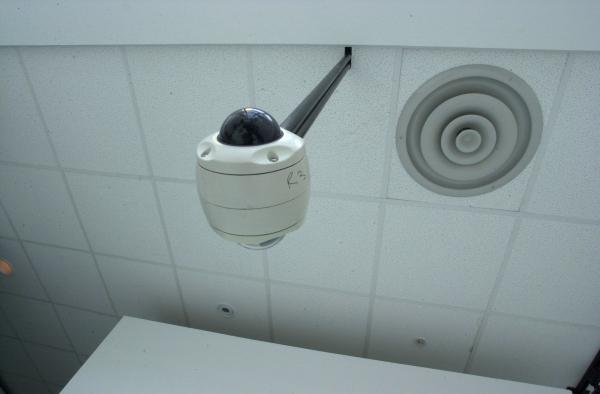
After the 12 men are processed, and clad in the white jumpsuits, they are led upstairs to the upper room, and out onto the roof.
When all of the men are clear from the decontrabanding gallery and decontamination gallery, there is a staff change, wherein the male decon officers are replaced with female decon officers, and then 12 women are admitted into the decontrabanding gallery. The process alternates, roughly 15 minutes for men, 15 minutes for women, and so on, until all of the attendees have processed through decon.
At this point there is a rooftop address: the keynote address (Mann) followed by an address by CAE's Steve Kurtz.
Then a wine and cheese reception took place one floor down, as the official opening of the exhibit, with informal discussion, etc..
The exhibit has hopefully raised a lot of important questions. In the wake of the anthrax attacks in the fall of 2001, this work has taken on a new relevance. Many questions remain unanswered, and need to be further explored through subsequent discussion.
Perhaps the most important as yet unanswered question is what happens when the new heroes of society are placed in such high regard that they fall outside the scope of scrutiny. Take for example the fireman. From fire extinguishers to riot extinguishers (big cans of pepper spray), the need for crowd control has been marketed as a new social order. And with fire hoses for crowd control the need for the fireman has changed from controlling fire to controlling people. As crowds of people are hosed down to prevent them from leaving the scene of a suspected white powder spill, one might ask: Is he the firefighter cum people fighter? Or has his Freudian desire to control fire merely evolved into a desire to control people?